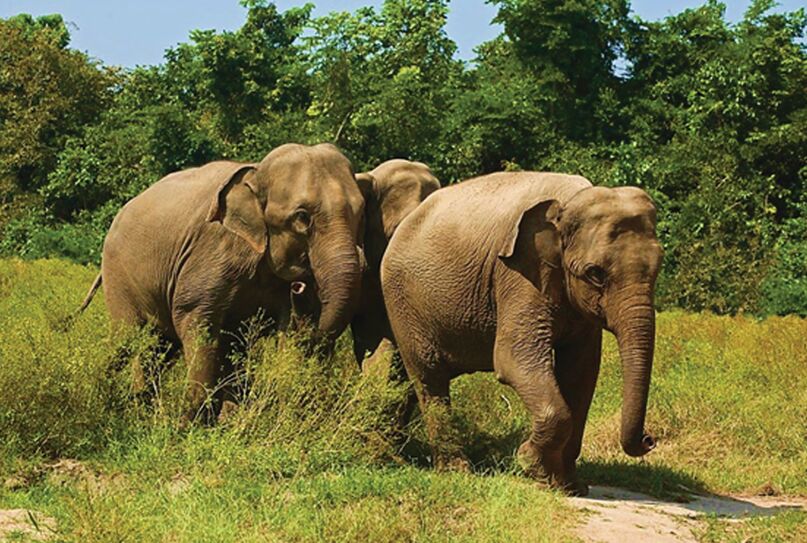COP15 side-event presents global lessons on biodiversity conservation in tropical forest landscapes
20 December 2022

Asian elephants are on the move near the Preah Vihear Protected Forest in Cambodia, an area of work of the ITTO–CBD Collaborative Initiative. Photo: Phnom Tamao Wildlife Rescue Centre/ Forestry Authority/Wildlife Alliance
Yokohama, Japan, 20 December 2022: A side-event convened by ITTO, the Convention on Biological Diversity (CBD) and the Institute for Global Environmental Strategies (IGES) at the 15th CBD Conference of the Parties (COP) has shared best practices on forest landscape restoration and sustainable forest management (SFM) in the Amazon, Mekong and Congo to improve livelihoods and biodiversity outcomes.
The side-event, which was held on 15 December, featured five expert speakers and was moderated by ITTO Projects Manager Hwan Ok Ma. It explored the outcomes of the Joint ITTO–CBD Collaborative Initiative for Tropical Forest Biodiversity, which has been running since 2011 and was renewed recently to 2025. The side-event also examined the conservation benefits of “other effective area-based conservation measures” (OECMs), which encompass management regimes other than strictly protected areas that achieve positive conservation outcomes.
“The ITTO–CBD Initiative has achieved extraordinary success in improving local livelihoods and forest management, restoring degraded forests and conserving biodiversity,” said Dr Ma. “ITTO strongly believes that OECMs, including the sustainable management of tropical production forests, make important contributions to biodiversity conservation while ensuring that local people benefit tangibly from their forests.”
At the side-event, Jamal Annagylyjova from the CBD Secretariat said that forests contain a large amount of the world’s terrestrial biodiversity but the world’s forest area is declining at an alarming rate, particularly due to deforestation in the tropics. She commended the achievement of the ITTO–CBD Collaborative Initiative for Tropical Forest Biodiversity over the past ten years and said she looked forward to its continued contribution to mainstreaming biodiversity in production landscapes.
In a keynote presentation, Ian Thompson, a forest biodiversity expert, reported on the lessons learned during implementation of the ITTO–CBD Initiative.
“The Collaborative Initiative contributed to positive effects on six of the Aichi Targets,” said Dr Thompson. “There is strong potential for the Initiative to work with the Global Environment Facility proposals to increase impacts.”
Mr André Mader, Programme Director at IGES, spoke about the role of OECMs in the post-2020 global biodiversity framework.
“Terrestrial biodiversity requires conservation beyond protected areas, and sustainable use of biodiversity in social ecological production landscapes is vital for human wellbeing,” he said.
In a video presentation delivered by Ambassador Carlos Laza, Ms María Alexandra Moreira López, Secretary-General of the Amazon Cooperation Treaty Organization (ACTO), outlined some of the challenges facing the eight ACTO member countries in managing their Amazonian forests sustainably for timber production and the collaborative efforts under way to do so.
“Collective efforts, including those of governments, the private sector and academia, are vital for building institutional and local capacities to effectively protect habitats and maintain ecosystem functions,” she said.
Professor Yongyut Trisurat from the Faculty of Forestry, Kasetsart University, Thailand, presented the key elements of collaborative management of the Emerald Triangle Protected Forests Complex, an important conservation area on the border between Cambodia, the Lao People’s Democratic Republic and Thailand. The transboundary conservation area benefited from a long-running ITTO project that was part of the ITTO–CBD Initiative.
“Transboundary cooperation reduces border disputes and enhances the livelihoods of local people living in the buffer zone,” said Professor Trisurat.
Professor Claude Kachaka Sudi, Regional Coordinator of the Network of Central African Forestry and Environmental Training Institutions, spoke about a forestry training programme in the Congo Basin supported by an ITTO project under the ITTO–CBD Initiative that improved professional competencies in SFM and biodiversity conservation.
“The development of twelve training modules on SFM and biodiversity, in correlation with the IUCN/ITTO biodiversity guidelines, has provided good impacts as a vital reference at many forests training centres in the region,” said Professor Sudi.
In closing remarks, ITTO Executive Director Sheam Satkuru thanked speakers for sharing lessons from the implementation of the ITTO–CBD Initiative and said the success of ITTO projects can be replicated beyond the project sites.
“We need to continue collaborating with all stakeholders on the sustainable management of tropical forests,” said Ms Satkuru. “Sustainable investment in SFM for conserving biodiversity and enabling local people to improve their livelihoods is critical towards the achievement of the global biodiversity framework.”
CBD COP15, which was held in Montreal, Canada, concluded on 19 December 2022.
Download the side-event presentations.